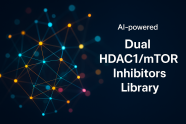 HOME
HOME ABOUT
ABOUT
 SERVICES
SERVICES
 PRODUCTS
PRODUCTS
 Targeted Libraries
Targeted Libraries
- SARS-CoV-2 Targeted Libraries
- SARS-CoV-2 RNA-dependent RNA Polymerase Targeted Library
- SARS-CoV-2 Main Protease Targeted Library
- Machine Learning SARS Targeted Library
- SARS-CoV-2 NSP16 Targeted Library
- SARS-CoV-2 Papain-like ProteaseTargeted Library
- SARS-CoV-2 Helicase Targeted Library
- SARS-CoV-2 Endoribonuclease Targeted Library
- SARS-CoV-2 Nonstructural Protein 14 (NSP14) Targeted Library
- Protein-Protein Interaction
- AI-powered Libraries
- Disease-Based Libraries
- Covalent Inhibitors Library
- Innovative Therapeutic Targets Library
- Targeted CELMoDs Collection
- USP30 Targeted Library
- tTG2 Inhibitor Library
- AHR Modulator Library
- G9a Targeted Library
- Epigenetic Targets
- Peptidomimetics
- Glycomimetics
- Protein Kinases
- Proteases
- GPCRs
- Nuclear Receptors
- Ion Channels
- RNA Binding
- SH2 Binding
- General Activities
- Other
- All Focused Libraries
- SARS-CoV-2 Targeted Libraries
 Biochemicals
Biochemicals
 RESEARCH
RESEARCH
 DOWNLOADS
DOWNLOADS ORDERING
ORDERING
 CONTACTS
CONTACTS
September, 2025 UPDATE:
Available Targeted Libraries:
|
AI-powered Libraries
|
|||||||||||||||




